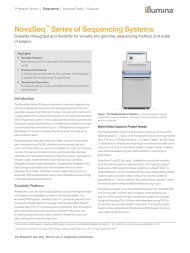Abstracts
ngsfinalprogram
ngsfinalprogram
You also want an ePaper? Increase the reach of your titles
YUMPU automatically turns print PDFs into web optimized ePapers that Google loves.
Poster <strong>Abstracts</strong><br />
uted across the genome, which suggests that<br />
hotspots within the genome may exist where it<br />
will be difficult to accurately detect differences<br />
between two samples. These results provide<br />
critical metrics that show the CFSAN SNP<br />
Pipeline to be a robust method for constructing<br />
a SNP matrix and further reinforces the utility<br />
and importance of validation exercises.<br />
n 3<br />
TGS-TB: TOTAL GENOTYPING SOLUTION<br />
FOR MYCOBACTERIUM TUBERCULOSIS<br />
USING SHORT-READ WHOLE-GENOME<br />
SEQUENCING<br />
T. Sekizuka 1 , A. Yamashita 1 , Y. Murase 2 , T.<br />
Iwamoto 3 , S. Mitarai 2 , S. Kato 2 , M. Kuroda 1 ;<br />
1<br />
National Institute of Infectious Diseases, Shinjyuku-ku,<br />
JAPAN, 2 Japan Anti-Tuberculosis Association,<br />
Kiyose-shi, JAPAN, 3 Kobe Institute<br />
of Health, Kobe-shi, JAPAN.<br />
Background: Whole-genome sequencing<br />
(WGS) with next-generation DNA sequencing<br />
(NGS) is an increasingly accessible and affordable<br />
method for genotyping hundreds of Mycobacterium<br />
tuberculosis (Mtb) isolates, leading<br />
to more effective epidemiological studies<br />
involving single nucleotide variations (SNVs)<br />
in the core genomic sequences based on molecular<br />
evolution. Methods: We developed an<br />
all-in-one web-based tool for genotyping Mtb,<br />
referred to as Total Genotyping Solution for<br />
TB (TGS-TB), to facilitate multiple genotyping<br />
platforms using NGS for spoligotyping and<br />
the detection of phylogenes with core genomic<br />
single nucleotide variations (SNVs), IS6110<br />
insertion sites, and VNTRs (our customized<br />
short TR on 43 loci) through a user-friendly<br />
simple click interface. In addition, this methodology<br />
is implemented with a KvarQ script<br />
to predict MTBC lineages/sublineages and<br />
potential antimicrobial resistance. Findings:<br />
The results of in silico analyses using TGS-TB<br />
are completely consistent with those obtained<br />
using conventional molecular genotyping<br />
methods, suggesting that MiSeq NGS short<br />
reads could provide multiple genotypes to<br />
discriminate multiple strains of Mtb. Indeed,<br />
seven Mtb isolates showing the same VNTR<br />
profile were accurately discriminated through<br />
median joining network analysis using specific<br />
SNVs unique to those isolates. Furthermore,<br />
an additional IS6110 insertion was detected<br />
in one of those isolates as supportive genetic<br />
information in addition to core genomic SNVs.<br />
The results obtained from all in silico analyses<br />
can be downloaded from the website. Interpretation:<br />
TGS-TB provides more accurate<br />
and discriminative strain typing for clinical<br />
and epidemiological investigations; NGS strain<br />
typing offers a total genotyping solution for<br />
Mtb outbreak and surveillance. The genotype<br />
information obtained for all Mtb isolates can<br />
be deposited into an integrated database for<br />
the surveillance of future outbreaks and global<br />
infections. TGS-TB web site: http://gph.<br />
niid.go.jp/tgs-tb Funding: This research was<br />
funded through a Grant-in-Aid for Research<br />
on Emerging and Re-emerging Infectious Diseases<br />
(H25-Shinko-Ippan-015) from the Ministry<br />
of Health Labour and Welfare Programs<br />
of Japan.<br />
n 4<br />
MARA: THE MULTI-ANTIBIOTIC RESISTANCE<br />
ANNOTATOR<br />
S. Partridge 1 , G. Tsafnat 2 ;<br />
1<br />
Westmead Millennium Institute, Sydney, AUS-<br />
TRALIA, 2 Centre for Health Informatics, Macquarie<br />
University, Sydney, AUSTRALIA.<br />
Much of the increasingly problematic multiresistance<br />
in Gram-negative bacteria is due<br />
to resistance genes associated with different<br />
mobile elements (mainly gene cassettes/<br />
integrons, insertion sequences, transposons)<br />
that tend to cluster together in complex multiresistance<br />
regions (MRR). MRR in turn are<br />
found on plasmids that can spread between<br />
cells, including different species, or sometimes<br />
in islands integrated into the chromosome.<br />
Increasing numbers of MRR sequences are<br />
becoming available as part of large projects<br />
using next-generation methods, enabling<br />
40<br />
ASM Conferences



